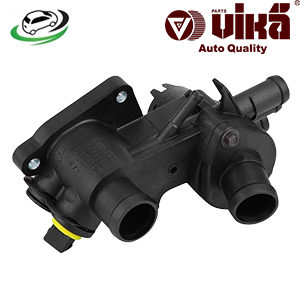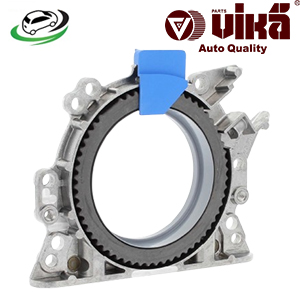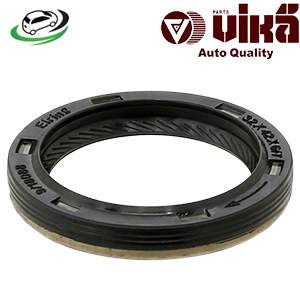-36%
Get Front crankshaft oil seal VW Golf VI 5K MK6 036103085H
The crankshaft oil seal is a critical component in an engine’s sealing system, playing a vital role in preventing oil leaks and maintaining engine integrity. Located at both ends of the crankshaft, this seal ensures that engine oil remains contained within the engine while keeping contaminants out. In this detailed guide, we will explore the function, construction, types, benefits, signs of wear, and maintenance of the crankshaft oil seal in 1000 words.
Function of the Crankshaft Oil Seal
The primary function of the crankshaft oil seal is to provide a reliable barrier between the rotating crankshaft and the engine’s exterior. This seal performs several key functions:
- Prevents Oil Leaks:
- Oil Containment: The crankshaft oil seal prevents engine oil from leaking out of the engine. It seals the gap between the crankshaft and the engine block or timing cover, ensuring that oil remains contained within the engine.
- Protects the Engine:
- Contaminant Prevention: The seal also helps to keep contaminants such as dirt, debris, and moisture out of the engine, which could otherwise lead to damage and performance issues.
- Maintains Proper Oil Pressure:
- Pressure Management: By preventing oil leaks, the crankshaft oil seal helps to maintain proper oil pressure within the engine. Adequate oil pressure is essential for the effective lubrication of engine components.
- Supports Engine Efficiency:
- Sealing Efficiency: The seal ensures that the engine’s oil system operates efficiently, which is crucial for overall engine performance and longevity.
Components of the Crankshaft Oil Seal
The crankshaft oil seal is composed of several key components that work together to ensure proper sealing:
- Seal Body:
- Material: Typically made from rubber or a composite material with high resistance to oil and heat.
- Function: The main body of the seal provides the sealing surface and maintains the barrier between the crankshaft and the engine.
- Metal Sleeve:
- Material: Often made from metal or a metal alloy.
- Function: The metal sleeve provides additional support and reinforcement to the seal, ensuring a tight fit and enhancing durability.
- Spring or Lip:
- Material: Made from metal or a flexible material.
- Function: The spring or lip inside the seal applies pressure against the crankshaft, creating a tight seal and preventing oil leakage.
- Gasket or O-Ring:
- Material: Usually made from rubber or silicone.
- Function: Provides a secondary seal between the oil seal and the engine block or timing cover to prevent leaks.
Types of Crankshaft Oil Seals
Crankshaft oil seals come in various designs, each suited to different engine configurations and applications:
- Single Lip Seal:
- Design: Features a single sealing lip that contacts the crankshaft.
- Application: Common in many engine designs, providing effective sealing for standard applications.
- Double Lip Seal:
- Design: Includes two sealing lips, with one facing the engine and one facing the outside.
- Application: Used in engines requiring enhanced sealing to prevent both oil leaks and contamination ingress.
- Spring Loaded Seal:
- Design: Incorporates a spring inside the seal to apply pressure against the crankshaft.
- Application: Provides a tight seal and is commonly used in high-performance or heavy-duty engines.
- V-Ring Seal:
- Design: Features a V-shaped profile that creates a seal against the crankshaft.
- Application: Often used in specific applications requiring a unique sealing design.
Benefits of a Properly Functioning Crankshaft Oil Seal
A well-maintained and properly functioning crankshaft oil seal provides several benefits:
- Prevents Oil Leaks:
- Leak Prevention: A properly functioning seal effectively prevents oil from leaking out of the engine, maintaining proper oil levels and preventing potential engine damage.
- Protects Engine Components:
- Contaminant Prevention: By keeping contaminants out, the crankshaft oil seal helps to protect sensitive engine components from damage and wear.
- Maintains Proper Oil Pressure:
- Pressure Management: The seal ensures that oil pressure remains within the optimal range, which is essential for effective engine lubrication.
- Supports Engine Efficiency:
- Performance: A functioning seal contributes to the overall efficiency of the engine, ensuring that it operates smoothly and reliably.
- Reduces Maintenance Costs:
- Prevention: By preventing leaks and protecting the engine, a properly functioning crankshaft oil seal can reduce the need for costly repairs and maintenance.
Signs of a Worn or Failing Crankshaft Oil Seal
Over time, the crankshaft oil seal can become worn or damaged due to exposure to heat, oil, and engine vibrations. Recognizing the signs of a faulty seal is important for timely maintenance and repair:
- Oil Leaks:
- Symptom: Visible oil leaks around the crankshaft area or under the vehicle can indicate a damaged or worn seal. Look for oil puddles or drips on the ground.
- Oil Smell:
- Symptom: A burning oil smell inside the vehicle or coming from the engine compartment can be caused by oil leaking onto hot engine components.
- Engine Noise:
- Symptom: Unusual noises such as whining or squealing may occur if the seal is not functioning properly and oil is leaking onto other engine parts.
- Low Oil Levels:
- Symptom: Consistently low oil levels may indicate a leak caused by a faulty crankshaft oil seal.
- Engine Performance Issues:
- Symptom: Poor engine performance or rough running can result from low oil levels or contamination caused by a failing seal.
Maintenance and Replacement
Regular maintenance and timely replacement of the crankshaft oil seal are essential for ensuring proper engine function and avoiding potential problems:
- Inspection:
- Routine Checks: Inspect the crankshaft oil seal and surrounding areas regularly for signs of wear, damage, or leaks. Ensure that the seal is securely in place and that there are no visible signs of leakage.
- Cleaning:
- Maintenance: Clean the area around the crankshaft oil seal to remove any dirt or debris that may affect performance or cause leaks.
- Replacement Interval:
- Manufacturer’s Recommendations: Follow the manufacturer’s recommendations for crankshaft oil seal replacement intervals. Replacement may be necessary if signs of damage or wear are observed.
- Professional Replacement:
- Expert Installation: If the crankshaft oil seal is damaged or needs replacement, it is recommended to have a professional mechanic perform the replacement to ensure proper installation and sealing.
- Sealant Application:
- Sealant Use: In some cases, a sealant or adhesive may be applied in conjunction with the new seal to ensure a complete and effective seal.
- Proper Installation:
- Installation Tips: When replacing the crankshaft oil seal, ensure that the new seal is properly aligned and seated. Follow the manufacturer’s specifications for torque and installation procedures.
- Check for Underlying Issues:
- Additional Checks: Address any underlying issues that may have caused the seal to fail, such as improper crankshaft alignment or excessive engine vibrations.
Follow us on Facebook for more parts.



